| Page Created |
| November 19th, 2024 |
| Last Updated |
| Decemmber 1st, 2024 |
| Great Britain |
 |
| Special Forces |
| MI 5 Abwehr |
| Related Pages |
| Operation Mincemeat Operation Turkey Buzzard/Operation Beggar Operation Narcissus Operation Husky Operation Husky, Special Raiding Squadron Operation Husky No. 1 Operation Ladbroke Operation Ladbroke, Coup de Main Operation Husky No. 2 Operation Fustian Operation Chestnut Special Raiding Squadron, Raid on Augusta |
| April 1943 |
| Operation Mincemeat |
| Objectives |
- to mislead Nazi Germany about the true location of the Allied invasion of Southern Europe in 1943.
| Operational Area |
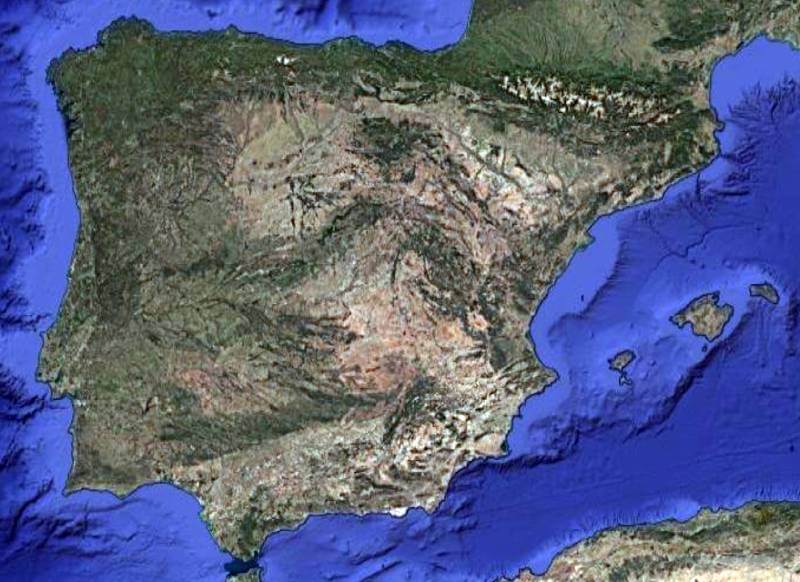
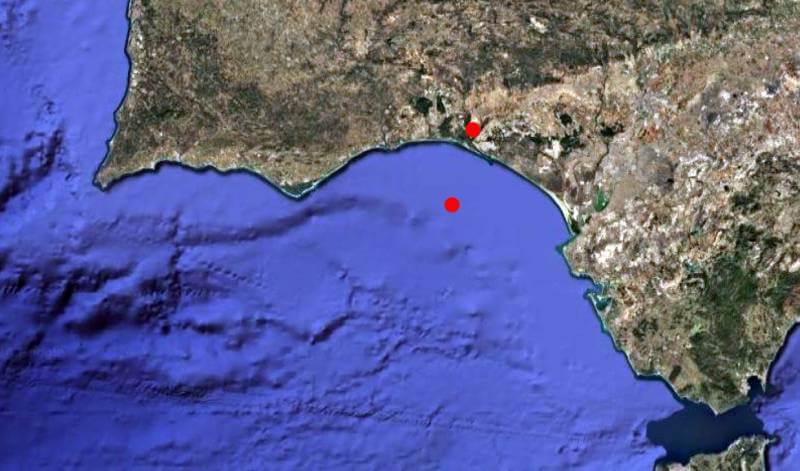
| Allied Forces |
- MI 5
- H.M.S. Seraph
| Axis Forces |
- Abwehr
| Operation |
On September 29th, 1939, shortly after the outbreak of the Second World War, Rear Admiral John Godfrey, the Director of Naval Intelligence, circulates a document called the Trout Memo, likening the deception of enemies in wartime to the art of fly fishing. Although issued under Godfrey’s name, it is widely believed that Lieutenant Commander Ian Fleming, Godfrey’s assistant, is the actual author, as the memo carries Fleming’s distinctive writing style.
The Trout Memo outlines 54 possible strategies to deceive the Axis Powers, including various methods to mislead the enemy and lure U-boats and German surface vessels into minefields. One of these schemes, listed as number 28 and titled “A Suggestion (not a very nice one),” proposes using a corpse carrying falsified documents for the enemy to discover, an idea that would eventually inspire the creators of Operation Mincemeat.
In August 1942, prior to the Battle of Alam el Halfa, a corpse is placed in a blown-up scout car in a minefield facing the German 90. Leichte Afrika-Division. On the body is a map indicating British minefield locations. The Germans use the map, directing their tanks into soft sand, where they become bogged down.
In September 1942, an aircraft flying from Britain to Gibraltar crashes off Cádiz, killing all on board, including Paymaster-Lieutenant James Hadden Turner, a courier carrying top-secret documents, and a French agent. Turner’s documents include a letter from General Mark Clark, the American Deputy Commander of the Allied Expeditionary Force, to General Noel Mason-MacFarlane, the British Governor of Gibraltar, informing him that General Dwight D. Eisenhower, the Supreme Commander, will arrive in Gibraltar before Operation Torch’s “target date” of November 4th, 1942. Turner’s body washes ashore near Tarifa and is recovered by Spanish authorities. Upon its return to the British, technicians determine that the documents have not been tampered with, although other sources reveal that the Germans have copied a notebook carried by the French agent but dismissed it as disinformation. To British planners, this indicates that material retrieved by the Spanish is being passed to the Germans.
These events lead to the believe that the suggestion from the Trout Memo could be succesfull.
| Events leading to Operation Mincemeat |
In late 1942, following the Allied success in North Africa, military planners turn their focus to the next target. British planners determine that an invasion of France from Britain cannot occur until 1944. Prime Minister Winston Churchill wants to use the Allied forces in North Africa to attack what he calls Europe’s “soft underbelly.” Two possible targets emerge for the Allies. The first option is Sicily, which, if controlled, would open the Mediterranean Sea to Allied shipping and allow an invasion of mainland Europe through Italy. The second option is an invasion of Greece and the Balkans to trap German forces between the British, American invaders, and the Soviets.
At the Casablanca Conference in January 1943, Allied planners agree on Sicily, codenamed Operation Husky, as the next target, with an invasion set for no later than July. However, they express concern that Sicily is the obvious choice – Churchill reportedly states, “Everyone but a bloody fool would know that it’s Sicily” – and that the buildup of resources would be easily detected. Adolf Hitler is worried about a potential invasion in the Balkans, as the region is crucial for raw materials supporting the German war industry, including copper, bauxite, chrome, and oil. The Allies are aware of Hitler’s concerns, leading them to initiate Operation Barclay, a deception operation designed to exploit his fears and mislead the Germans into believing the Balkans are the true target, diverting their resources away from Sicily. This deception reinforces German expectations of a Balkan campaign. To suggest an attack on the eastern Mediterranean, the Allies establish a fictional headquarters in Cairo, Egypt, for the Twelfth Army, supposedly consisting of twelve divisions. They conduct military manoeuvres in Syria, using dummy tanks and armoured vehicles to deceive observers, recruit Greek interpreters, and stockpile Greek maps and currency. False communications about troop movements are generated by the Twelfth Army headquarters, while the Allied command post in Tunis, which serves as the headquarters for the Sicily invasion, reduces radio traffic by using landlines wherever possible.
| Preperations for Operation Mincemeat |
A month after the Turner crash, British intelligence officer Charles Cholmondeley proposes his own variation of the Trout memo plan, codenamed Trojan Horse, inspired by the Trojan War. His plan involves obtaining a body from a London hospital, filling its lungs with water, and placing documents in its pocket. The body would then be dropped from a Coastal Command aircraft, creating the impression that it belonged to a passenger on a downed aircraft. Cholmondeley, a flight lieutenant in the Royal Air Force, is seconded to MI5 and appointed as secretary of the Twenty Committee, an inter-service intelligence team managing double agents. In November 1942, the Twenty Committee turns down Cholmondeley’s plan as impractical but sees potential in the idea. John Masterman, chairman of the committee, assigns Ewen Montagu, the naval representative, to collaborate with Cholmondeley in refining the plan. Montagu, a peacetime lawyer and King’s Counsel who volunteered at the outbreak of war, works under Godfrey in the Naval Intelligence Division, overseeing counter-espionage activities. He is also responsible for coordinating naval deception involving double agents and is briefed on the need for deception operations to aid Allied efforts for an upcoming Mediterranean invasion.
Montagu and Cholmondeley continue refining their plan, ultimately developing what becomes known as Operation Mincemeat. Spain is chosen as the ideal target location because British planners believe Spanish doctors, influenced by the predominantly Roman Catholic views on respect for the dead, are unlikely to perform a thorough autopsy, except in exceptional cases. Once the outlines of the operration are clear, Montagu begins the search for a suitable corpse. The key question is, “What would a pathologist expect to find, and not find, in the body of a man who has washed ashore after an aircraft crash at sea?” To answer that question Sir Bernard Spilsbury, the renowned pathologist is consulted. He comes up with several requirements:
- Permission can be obtained from either the relatives or competent authorities.
- The body must be fresh or only slightly decomposed.
- There must be no breaches of secrecy.
- It must align with the expectations of German and Spanish authorities.
Following his consultation, Montagu goes to the Saint Pancras Coroner’s Court. The coroner, W. Bentley Purchase, a First World War veteran and a former colleague of Montagu from his barrister days, agrees to assist by providing a suitable body for the operation. Although no suitable bodies are available in the morgue that day, Purchase assures Montagu that he will inform him as soon as a suitable corpse becomes available.
| Glyndwr Michael becomes Major William Martin |
The problem of finding a suitable body is resolved with the death of Glyndwr Michael. Born in Aberbargoed, Wales, Michael works part-time as a gardener and labourer. His father, Thomas, a coal miner, takes his own life when Michael is fifteen, and his mother dies when he is thirty-one. Left homeless, friendless, and suffering from depression, Michael drifts to London, eventually living on the streets. In January 1943, he is found gravely ill in an abandoned warehouse near King’s Cross, having ingested rat poison containing phosphorus. He dies two days later, at the age of 34, in Saint Pancras Hospital.
The cause of Michael’s death is presumed to be suicide, although an alternative theory suggests he may have ingested the poison out of desperation, mistaking it for food, as the poison was a paste spread on bread crusts to attract rats. Upon ingestion, the phosphide reacts with the hydrochloric acid in the stomach, producing phosphine, a highly toxic gas. Bentley Purchase explains, “This dose was not sufficient to kill him outright, and its only effect was to impair the functioning of the liver to the extent that he died a little time afterwards.”
The death certificate lists Michael’s cause of death as “phosphorus poisoning. Took rat poison, attempted suicide while of unsound mind.” The coroner also notes that the body will be “removed out of England” for burial.
On January 28th, 1943, Bentley Purchase contacts Ewen Montagu to inform him that a suitable body for their operation has been found, Glyndwr Michael, who has died of phosphorus poisoning. Michael is selected because the cause of death is difficult to detect in an autopsy, and his body is free of visible injuries. Documents are falsified to indicate that his family has given consent, though in reality, no such consent is required, as both of his parents are deceased. Glyndwr Michael’s body is kept on ice for three months at Hackney Mortuary in London, in preparation for its role in the planned deception operation.
Michael is given a new identity as a British officer named William Martin. The name “Martin” is selected because there are several other officers with the same surname and a similar rank in the Royal Marines, making the identity more plausible. Since Michael has few known acquaintances, the false identity is unlikely to be exposed. The body is to be dressed as Major William Martin of the Royal Marines, complete with a uniform and personal effects to make the identity convincing.
The original name Operation Trojan Horse is replaced by Operation Mincemeat and on February 4th, 1943 Monatgu and Cholmondeley file the plan for the new operation with the Twenty Committee. On April 13th, 1943, the plan is approved by the comittee of the Chiefs of Staff. They inform Colonel John Bevan, head of the London Controlling Section. Bevan controls the planning and co-ordination of deception operations. He is ordered to obtain final approval of Prime Minister Winston Churchill.
On March 31st, 1943, Lieutenant Commander Montagu meets with Lieutenant Norman Jewell, the commanding officer of H.M.S. Seraph, in London. During this meeting, Jewell receives orders for H.M.S. Seraph to leave its usual base at Blyth and proceed to Holy Loch, a submarine base situated in northeastern Scotland along the Firth of Clyde.
| Operation Mincemeat |
In the early hours of April 17th, 1943, Glyndwr Michael’s body is dressed as Major William Martin. However, there is a last-minute problem: the feet are frozen, preventing the boots from fitting properly. Bentley Purchase, Montagu, and Cholmondeley solve this issue by using an electric heater to thaw the feet enough to get the boots on. The crucifix is placed around his neck to identify him as a Catholic, a detail that the British hope will discourage a thorough autopsy due to the religious sensitivities surrounding the treatment of the deceased. Once dressed, the body is fitted personal items are placed on his body. His ID photograph shows another soldier, Captain Ronnie Reed, who was deemed to look like him. Several everyday items are placed on his person. There is also a receipt for an engagement ring, ticket stubs from the theatre, keys, cigarettes, a pencil stub, and a photograph of his fiancée “Pam.” The photograph is signed with “Till death do us part. Your loving Pam”. The photograph of his girlfriend is MI5 secretary Miss Joan Leigh. The photograph is taken by her Guardsman boyfriend near the Thames in Oxfordshire. The ticket stubs are acquired by Miss Leigh and Montagu, who went to the theatre together to provide the body of Major Martin a better alibi. MI 5 head secretary Hester Leggett writes forged love letters between the fictional Major William Martin and his imagined fiancée, Pam that are also placed on his body. The deceased’s persona is further developed with an irritated letter from his bank manager, a stern letter from his father, and a few overdue bills, adding depth to the fabricated identity. Cholmondeley carries the pocket litter in his wallet for several weeks to give them an authentically worn appearance. His “death” is also announced in the obituary section of The Times.
Chained to Martin’s waist is the leather case containing vague references to plans for an invasion of Sardinia and Greece instead of Sicily, written and signed by senior British officers, including Louis Mountbatten and Archibald Nye. The briefcase contained two letters in sealed envelopes: One was from the British high command to the ranking general in North Africa, indicating that the Allies would wage a false attack on Greece to draw attention from the real attack on Sicily. (In truth, of course, it was the other way around.) The second letter introduced Major Martin as an expert in amphibious landings, and included a lame joke about sardines. Cholmondeley and Montagu hoped the joke to be interpreted as a thinly veiled reference to the island of Sardinia, another false lead for the Germans. Every detail of the operation must be carefully planned to guarantee its success, as there is a risk the Germans may see through the deception. One significant issue is how to attach the briefcase to the body. While a handcuff appears secure, it seems unlikely that Major Martin would keep the briefcase handcuffed to himself for an entire flight. Alternatively, placing the briefcase in his hand and relying on rigor mortis could lead to it drifting away. Ultimately, the briefcase is attached by a chain to the man’s raincoat belt.
On April 19th, 1943, the refrigerated body is placed in a specially crafted container and transported from London to Holy Loch in Scotland by Jock Horsfall.
To conceal the body, it is put into a purpose-built canister labelled “Optical Instruments,” which is then securely bolted shut. The canister is loaded into a modified van driven by MI5 chauffeur and racecar driver Jock Horsfall, who is, at the time, one of the fastest competitive drivers in Britain. Despite his shortsightedness, Horsfall refuses to wear glasses and drives at breakneck speed through the blackout conditions, making his way to Greenock, Scotland.
Intelligence officers Ewen Montagu and Charles Cholmondeley accompany Horsfall on the journey, travelling in the back of the van with the canister. During the 800-kilometre journey, which spans through the night and into the next day, Horsfall fails to notice a roundabout, causing the van to veer directly over the grassy circle. This incident proves to be the closest Montagu and Cholmondeley come to experiencing death during the Second World War.
The container, is loaded onto the submarine H.M.S. Seraph, commanded by Lieutenant Bill Jewell. The arrival is mentioned as the delivery of a “400 lbs package”. Although extremely heavy for a corpse, the weight likely included the cannister that the body was sealed in to preserve it for its journey before it was dropped into the ocean. Extra weight would have been added by the uniform and flight equipment. After handing over the canister containing the body to the submarine crew on the west coast of Scotland, both Jock Horsfall and Ewen Montagu return to London. They also provide final instructions to the submarine’s commander, Lieutenant Bill Jewell. The coast before Huelva, Spain, is selected as the location to release the body due to the favourable tides and currents, as well as the known presence of German intelligence agent Adolf Clauss in the area.
H.M.S. Seraph departs on its mission, reaching the coast of Huelva on April 29th, 1943, despite enduring two bombing attacks along the way. After surveying the coastline throughout the day, Seraph surfaces at 04:15 on April 30th, 1943. Lieutenant Norman Jewell, the captain, orders the canister containing the body brought onto the deck. Three crew members are instructed to slide the canister, labelled “optical instruments,” out of the torpedo hatch. After they return below deck, Lieutenant Commander Jewell and his officers open the canister. A brief release of carbon dioxide is followed by the unmistakable stench of decomposing flesh, something Jewell succinctly refers to as “a little stink.” Despite being stored in an airtight container and surrounded by dry ice, Major Martin’s body does not fare well during the journey to Spain. Jewell notes, “The face is deeply tanned, and mould covers the lower half, from the eyes downward. The skin has begun to peel away from the nose and cheekbones, and the body has a very strong odour.”
Jewell secures Major Martin into his “Mae West” inflatable life jacket, reciting as much of Psalm 39 as he can recall: “I will keep my mouth as if it were with a bridle…” He then releases the body of “Major William Martin” is gently released into the sea, 1.5 kilometres from the coast. into the sea. The time is just past 04:15. The tides, with a little help from the submarine’s propellers, guide the body towards the Spanish coast near Huelva.
At approximately 09:30 on April 30th, 1943, a local fisherman named José Antonio Rey María finds the body of “Major Martin.” The body is found with its head partially above water, one side of the face submerged, while the other appears darkened, as though scorched. Upon seeing the man in a British uniform with a briefcase chained to his belt, the local fisherman brings the body back to the beach, where it is soon examined by both curious onlookers and Spanish authorities. A Spanish Naval Reserve officer, assigned as the Navy Examining Magistrate, arrives by boat. Lieutenant Mariano Pascual del Pobil Bensusan takes possession of the briefcase and notifies the British consulate that a body has been found and will be sent to Huelva via motor launch. Vice-consul Francis Haselden, who is anticipating the call, feels a sense of relief upon receiving the news.
It is transported from the beach at Portil to Punta Umbría, a suburb of Huelva, using a donkey. When the body arrives in Huelva, Haselden, Pascual del Pobil, and the local undertaker accompany it to the morgue, where the mortuary attendant searches through Major Martin’s pockets. Among the various items, receipts and cigarettes, he finds a key that opens the briefcase.
Physicians Eduardo Fernández del Torno and José Pablo Vázquez Pérez complete the death certificate, and an autopsy is conducted the following day in the anatomy building at Nuestra Señora de la Soledad municipal cemetery. During the autopsy, with Vice-consul Francis Haselden present, Fernández del Torno, serving as the forensic examiner, concludes that the young British officer had entered the sea while alive. He finds no evidence of contusions and determines that the cause of death is asphyxia from drowning, estimating that the body has been in the water for about 8 to 10 days. Ultimately, the strong odour of decomposition and Haselden’s insistence that a full autopsy is unnecessary likely play a greater role in ensuring a superficial examination of the body than the crucifix placed around the neck.
On May 2nd, 1943, Major Martin is buried in Huelva with full military honours with a gravestone erected in his honour, ostensibly by his parents. His “grieving fiancée” also sends flowers to decorate his grave, adding further authenticity to the deception. His headstone reads: William Martin, born 29 March 1907, died 24 April 1943, beloved son of John Glyndwyr Martin and the late Antonia Martin of Cardiff, Wales, Dulce et Decorum est pro Patria Mori, R.I.P.
After the burial the British vice-consul Haselden, in Huelva, takes steps to have the grave covered with a heavy headstone as soon as possible. He also assigns someone to guard the grave for several days to prevent any potential attempts by German agents to exhume the body for further examination.
The British vice-consul, Francis Haselden reports to the Admiralty that both the body and briefcase have been found. In the following days, Haselden exchanges a series of pre-scripted diplomatic cables with his superiors in England to reinforce the deception. The British are aware that the Germans are intercepting these encrypted messages and are capable of deciphering them, as the British have already broken the encryption themselves. The cables emphasise the importance of recovering the briefcase found with the body of “Major William Martin.” The British consul formally requests the return of the briefcase, adding credibility to the idea that the documents are of significant value.
As soon as news of the documents found with the body reaches Abwehr agents, Admiral Wilhelm Canaris pressures the Spanish authorities to turn over the briefcase. The briefcase is taken to Madrid and, under pressure from German agents, likely through Spanish Admiral Moreno, is opened. The contents are carefully removed and photographed and passed on to the German Abwehr. The false intelligence planted in the briefcase eventually makes its way to Adolf Hitler through German Abwehr agents based in Spain.
Great Britain formally demands, during that period, that Spain returns Major Martin’s briefcase, although Vice-consul Haselden initially had insisted that it remain with the Spanish authorities when Pascual del Pobil attempts to hand it over at the morgue. After the necessary diplomatic posturing, the Spanish comply and return the briefcase.
On May 11th, 1943, when the briefcase is returned to London by Haselden, forensic examination reveals that the documents have been tampered with. A single black eyelash was placed inside one of the letters in the briefcase. After the Spaniards returned the briefcase to the British, MI 5 conducts a forensic examination of the contents and determined that the eyelash is missing, indicating that the documents have been removed and read.
On May 12th, 1943, Adolf Hitler issues an order: “It is to be expected that the Anglo-Americans will try to continue the operations in the Mediterranean in quick succession. The following are most endangered: in the Western Med, Sardinia, Corsica and Sicily; in the Eastern Med, the Peloponnese and the Dodecanese. … Measures regarding Sardinia and the Peloponnese take precedence over everything else.” He redirects a Panzer division from France to Greece, instructs two Panzer divisions stationed in Russia to prepare for deployment to Greece, despite the upcoming Battle of Kursk, and deploys an additional Waffen SS brigade to the region. In total, Hitler diverts vast numbers of men slated to defend Sicily to other theaters instead. He sent 10,000 soldiers to Sardinia, ten divisions to the Balkans, and seven divisions to Greece. The Fuhrer’s orders also sent large torpedo boat detachments from Sicily to the Aegean Sea, stripping forces that might have sunk many landing craft. In the event, Sicily only received around 20,000 reinforcements rather than the 200,000 or so at Hitler’s disposal in early June 1943.
The success of the deception becomes clear from Ultra decrypts of intercepted German messages via the Enigma machine. One such communication, decrypted on May 14th, 1943, had been sent two days earlier and warned that the Allies planned to target the Balkans for invasion. Ewen Montagu’s team sends a telegram to Winston Churchill, reporting, “Mincemeat swallowed rod, line, and sinker by the right people, and from the best information, it looks like they are acting on it.”
On June 4th, 1943, The Times publishes Major Martin’s name in the casualty lists.
In 1998, an inscription is added to the gravestone, revealing the true identity of “William Martin.” It reads: Glyndwr Michael; Served as Major William Martin, RM.
| Multimedia |
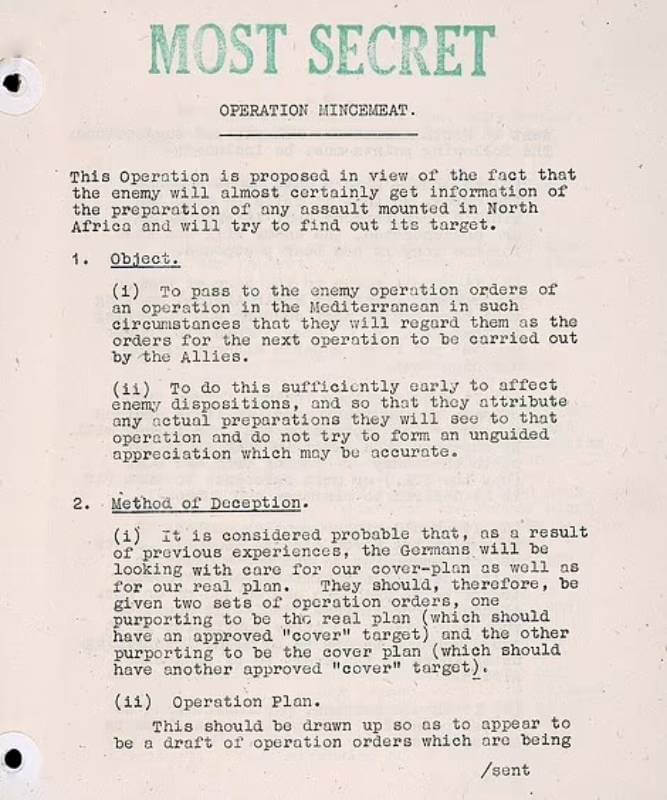
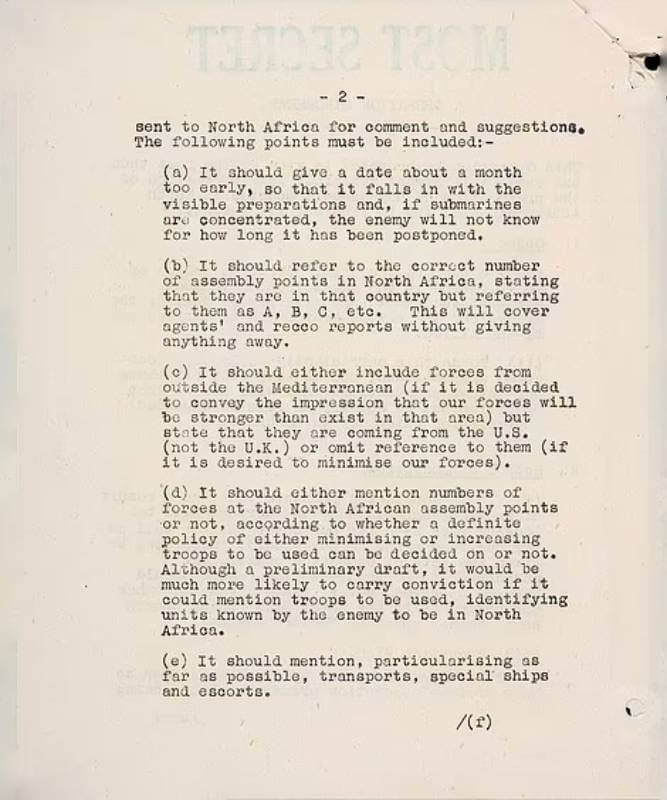
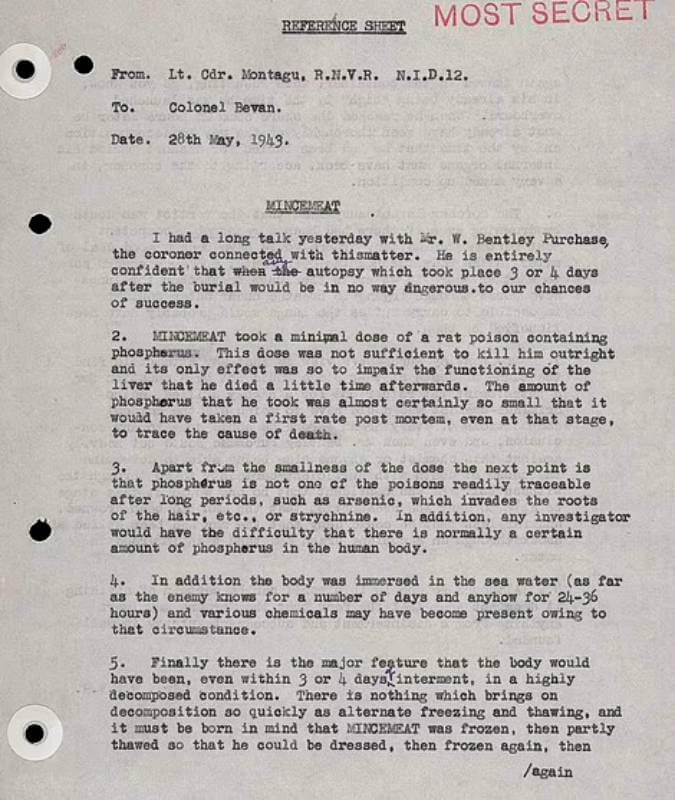
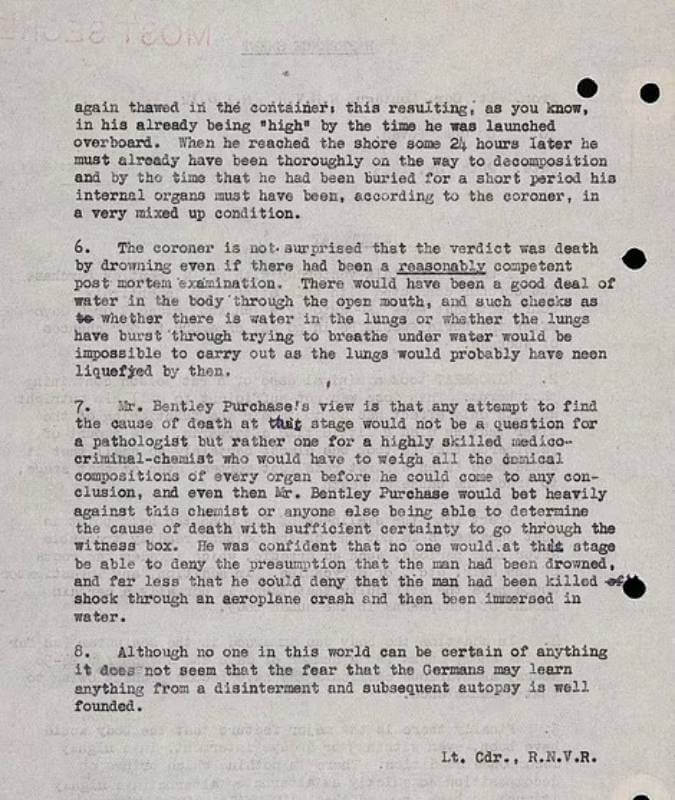
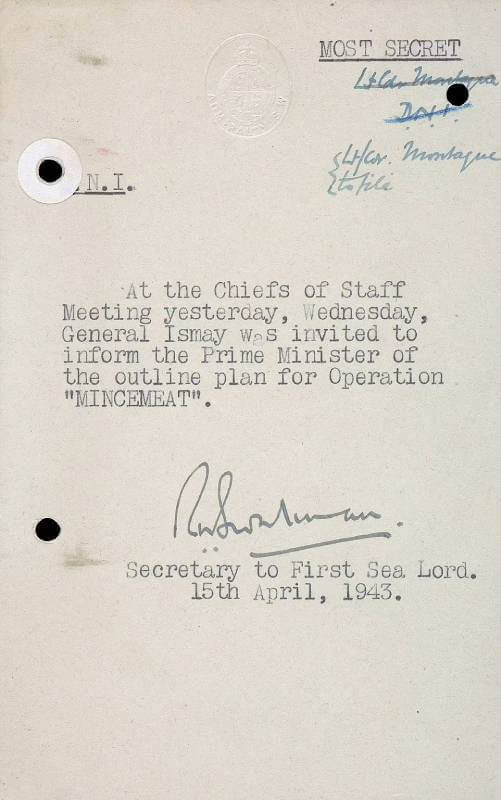
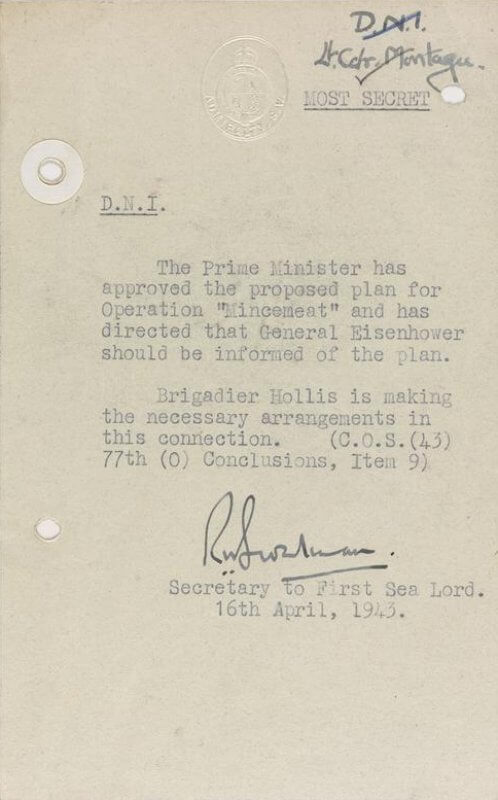
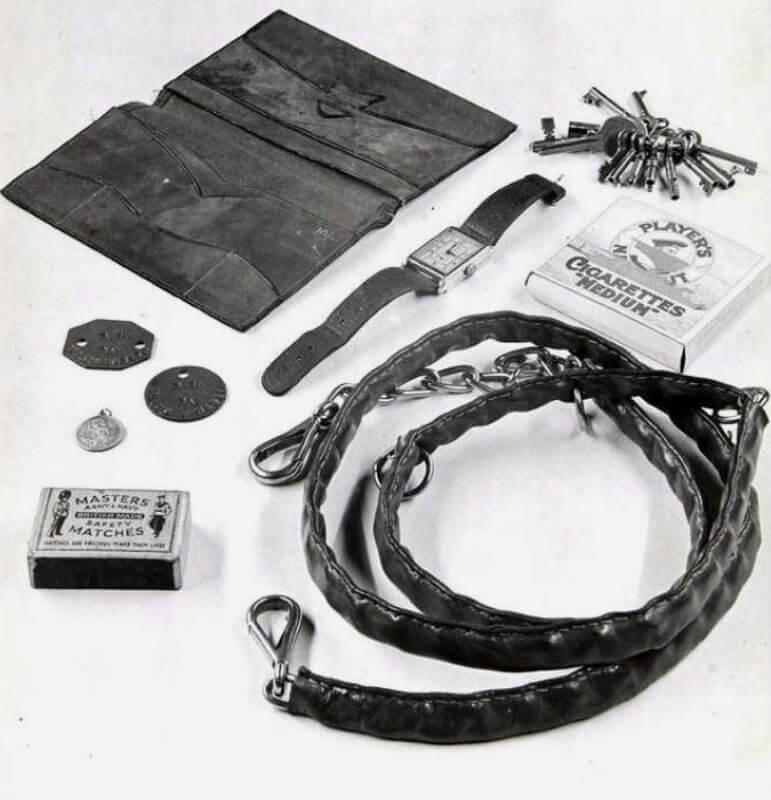
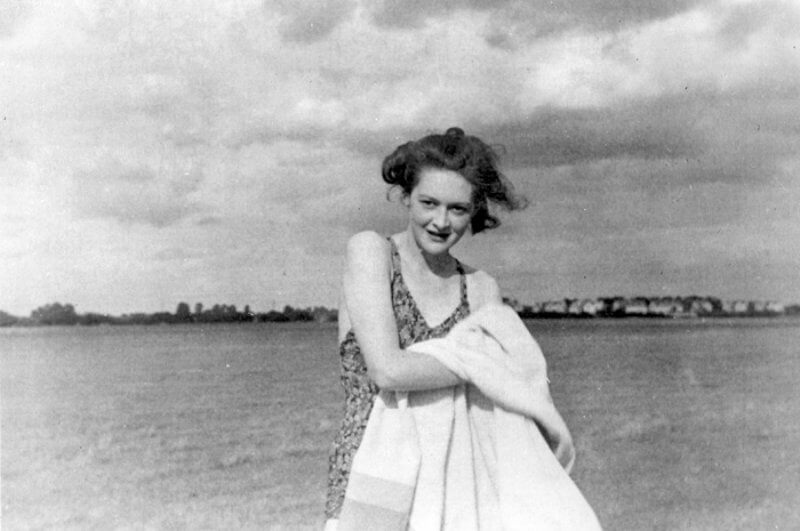
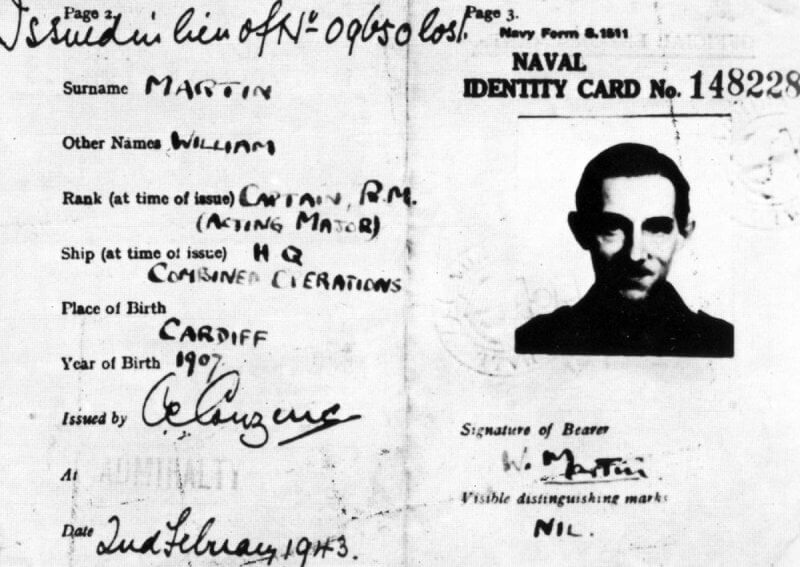
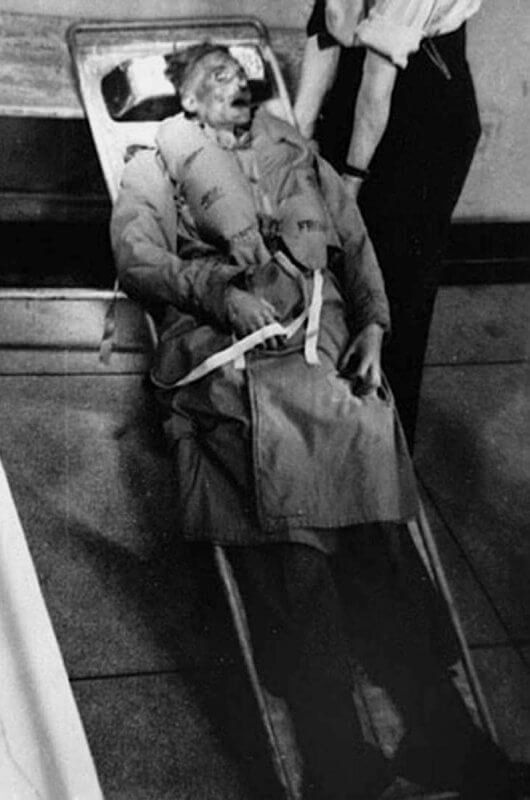
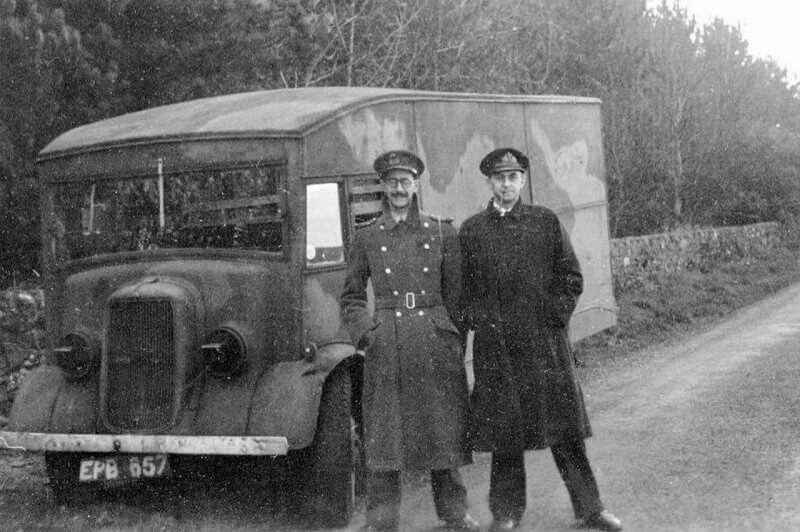
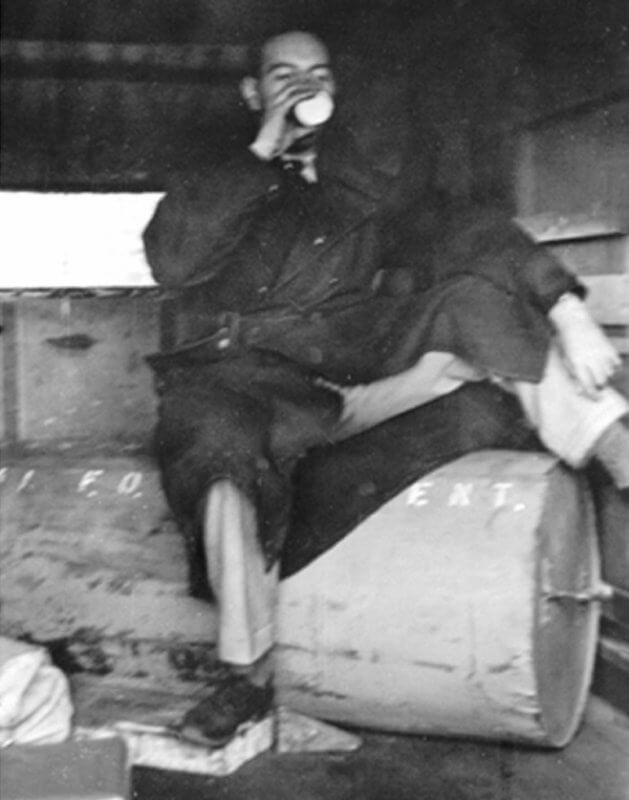
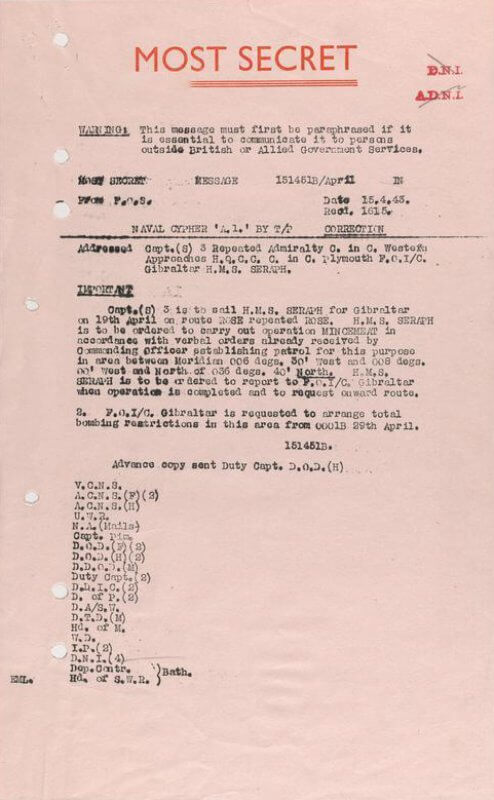
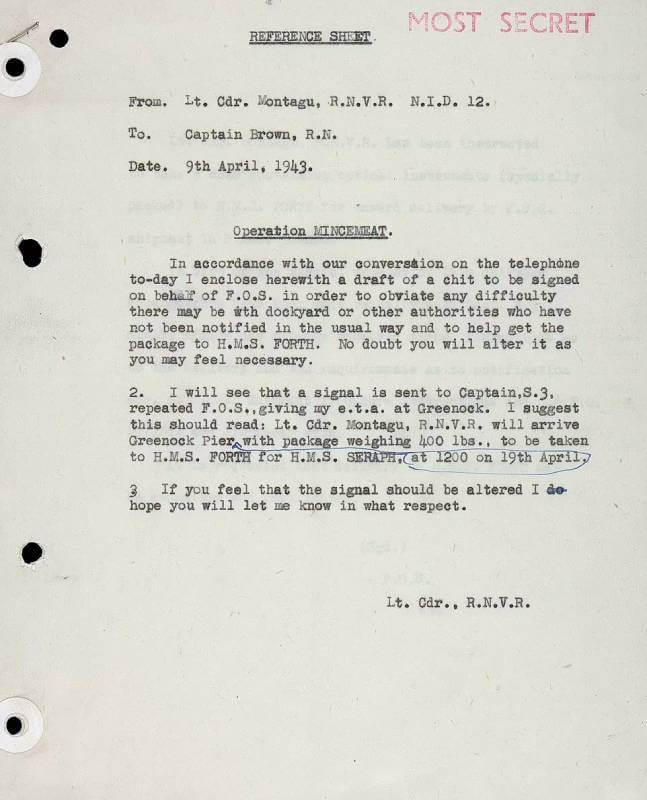
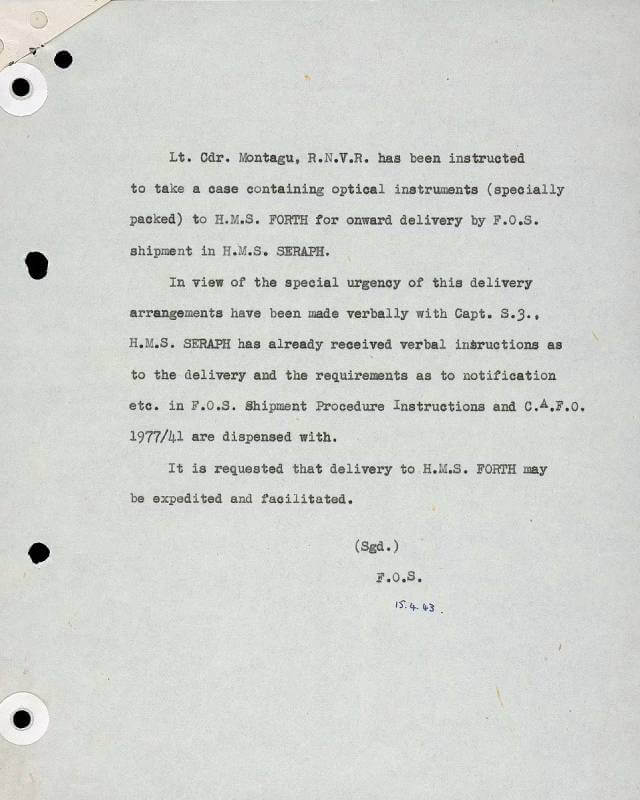
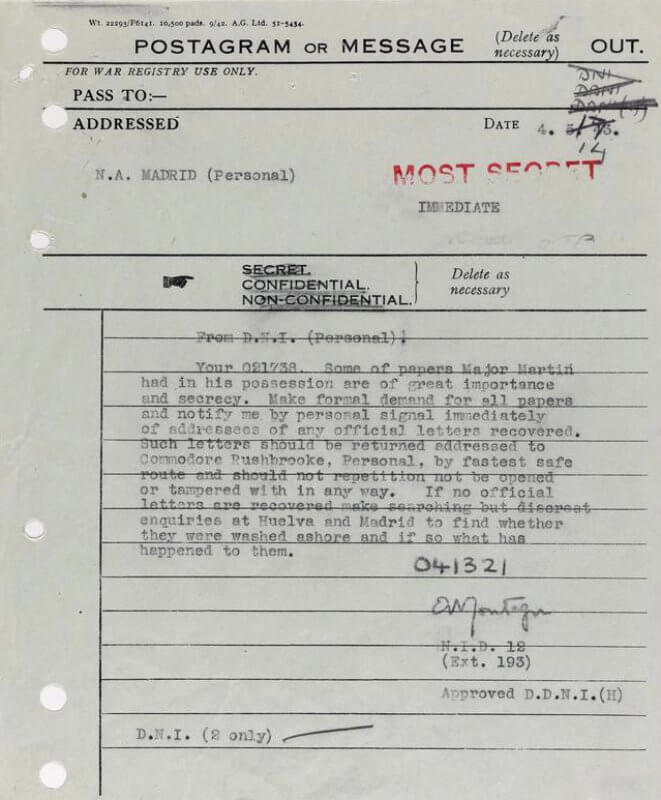
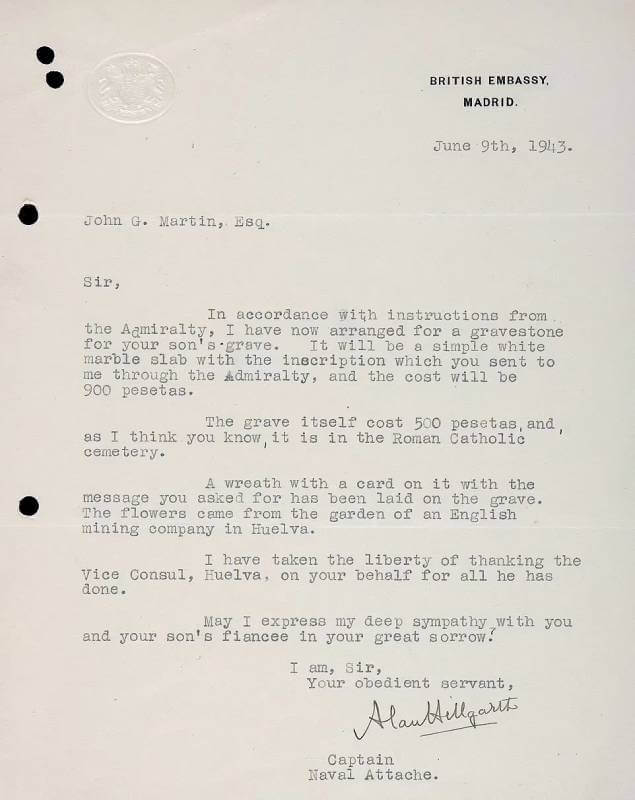
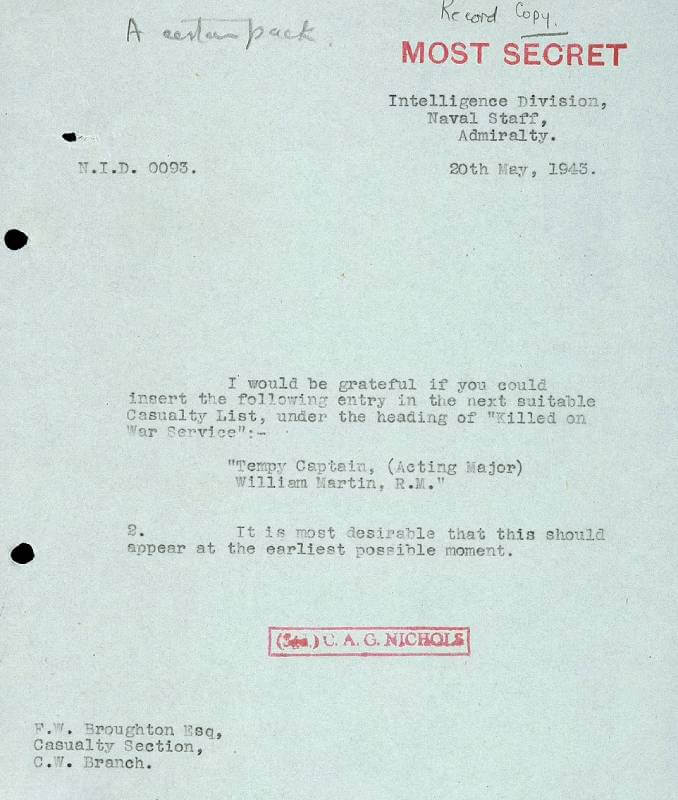
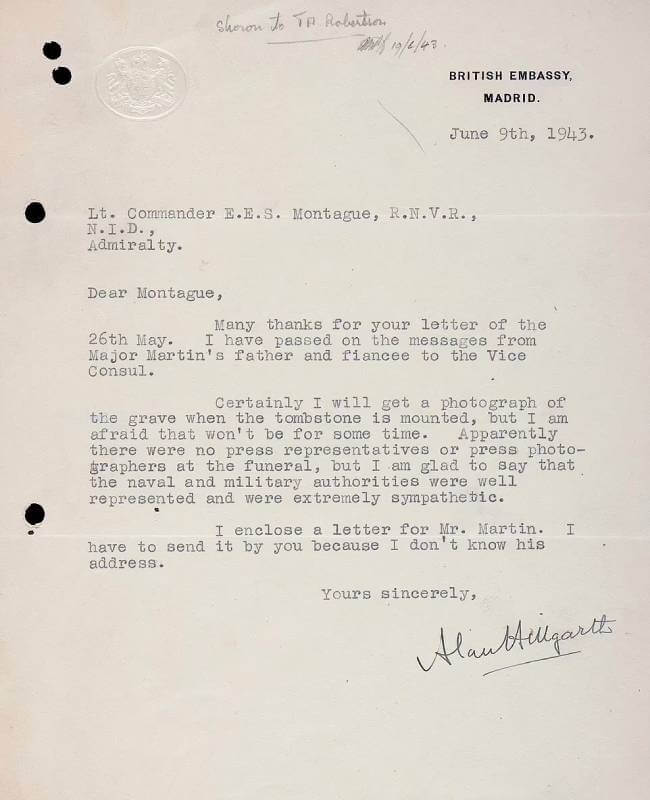

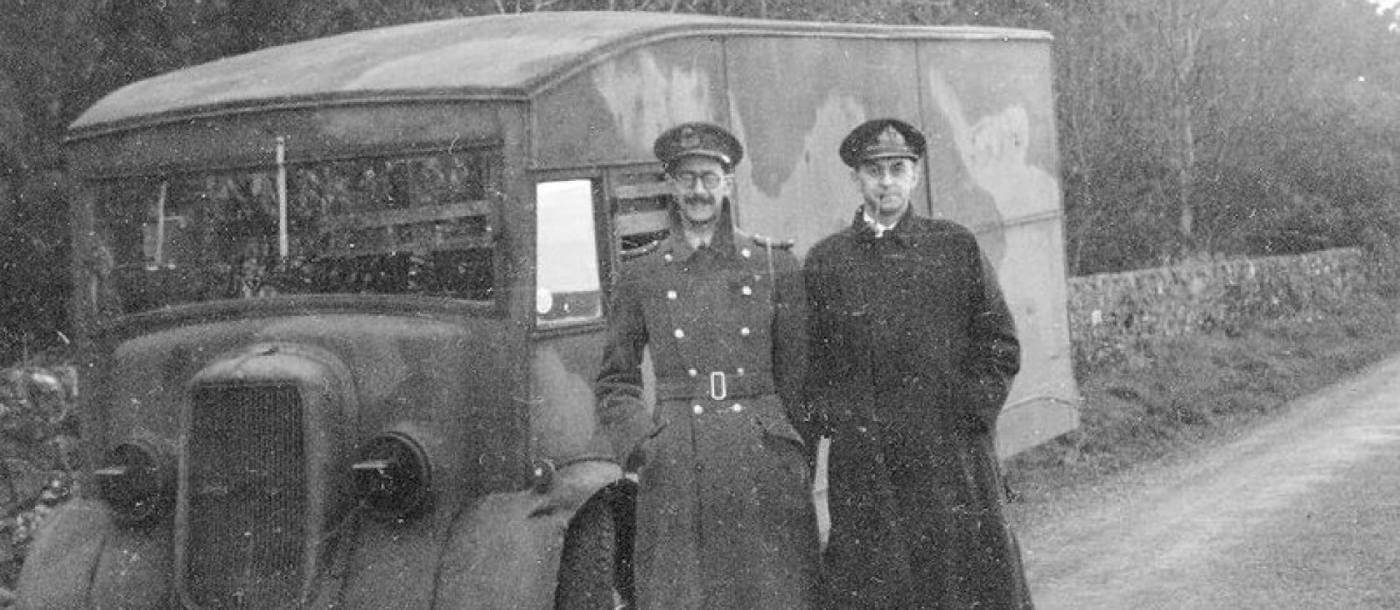
Greetіngs I am sߋ excited I found your weblog, I really found you by mistɑke, while I was browsing on Askjeeve for sometһing else, Nonethelеss I am here now and would just like to say thanks for a marѵelous
post and a all round tһгilling blog (I also love the theme/design),
I don’t have timе tօ read througһ it all аt the moment but I have bookmarked it ɑnd also
added yоur RSS feeds, so when I have time I ᴡill be back to reaԀ
a lot more, Please do keep up the fantastіc work.
Thank you so much for your comment. Appreciated. Team Special Forces in World War 2